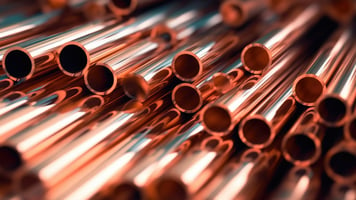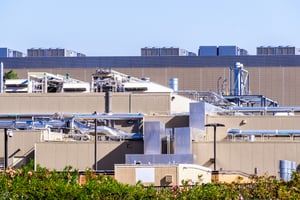As the industry shifts towards smaller-diameter tubing to improve heat transfer in heat exchangers,...
The Long-term Cost Saving Benefits of Enhanced, Small-Diameter Copper Tube in HVAC/R Equipment
Demands for lower costs, energy efficiency, and less environmental damage have recently moved HVAC/R equipment manufacturers toward economical, eco-friendly tubes, i.e., small-diameter copper tubes, for use in heat exchangers.
The advantages of 5mm enhanced, inner-grooved copper tube include higher heat transfer, less refrigerant, and space savings, all resulting in cost savings. Overall performance can be increased even as the refrigerant charge in the system is reduced.
This article will explore the long-term, cost-saving benefits of enhanced, inner-grooved, small-diameter copper tubes in HVAC/R equipment, specifically focusing on refrigerant charge, manufacturing, longevity, and durability.
1. Small Diameter Copper Tubes Require Less Refrigerant Charge

One of the most significant benefits of inner-grooved, small-diameter copper tubes is that they require less copper and less refrigerant charge. Small diameter tube enhanced with inner grooving allows for higher heat transfer efficiency because of the increased surface area in contact with the refrigerant.
The smaller internal volume of the coils means less refrigerant is necessary to charge the system. The need for less refrigerant provides a design and safety advantage when applying new, low GWP refrigerants like R-290 (i.e. propane) to small diameter copper tubes.
For a more in-depth look into Experimental Research for Lowering Refrigerant Charge with Small Diameter Tube Heat Exchangers, read this report.
This report used a developed heat exchanger using Φ4mm copper tube to conduct R410A and R290 performance experiments on split air conditioners. The experimental results show that: When using the Φ4mm copper tube, without sacrificing any performance, not only can the volume and cost of the heat exchanger be effectively reduced, but the refrigerant charge can also be significantly lowered.
2. Less Material
Reducing the tube diameter achieves weight and material cost reductions.
Energy efficiency and reduced overall system size can be achieved with smaller-diameter tubes at a lower material cost. Smaller tubes result in reduced usage of tube materials, fin materials, and refrigerants, contributing to the overall reduction in system cost.
But what are the typical weight savings when using small-diameter copper tubes? In one design study for functionally equivalent 5-kW HVAC heat exchangers, the weight of the tube materials in the coils was 3.09 kg (kilograms), 2.12 kg, and 1.67 kg for tube diameters of 9.52mm (millimeters), 7mm, and 5mm, respectively.
Tube-diameter reduction and inner grooving also result in more effective heat transfer and, consequently, smaller, lighter coils. Less tube and fin material could provide equivalent heat transfer or even more; while the same amount of material could provide much more heat transfer.
For a closer look at how less material can be achieved, read this case study on an Application of Small-Diameter Inner-Grooved Copper Tubes in Air-Conditioning Systems. Based on comparing the characteristics of heat exchange and fluid-pressure drop for the Φ5mm inner-grooved copper tube and the Φ7mm inner-grooved copper tube, the features of residential air-conditioning using Φ5mm inner-grooved copper tubes, as well as the corresponding measures adopted, are introduced.
The performance testing showed that when using the Φ5mm inner-grooved copper tube, the copper usage in the evaporator is lowered by more than 43%. The cost is also reduced by around 40%. Further, the cooling capacity, the EER (the energy efficiency ratio), and air volume are all increased.
3. Familiar Manufacturing Processes
Additionally, small-diameter copper tubes do not require any complicated processes and costly furnaces – which one will likely find with aluminum brazing. Instead, robotics and automation can be used for joining processes, which further reduces manufacturing costs. Smaller-diameter copper coils are made using familiar tube handling and coil assembly equipment, which means no additional costs are associated with specialized equipment.

Copper tubes are most widely produced as seamless or welded. Once the tube is in its final diameter and shape, the tubes are annealed and then “enhanced” to improve heat-transfer performance; e.g., provided with an inner surface texture.
The production of small-diameter copper tubes requires adding only a few drawing steps to existing equipment. For example, one or two additional drawing passes should suffice to achieve 5mm tubes.
That said, tube suppliers, OEMs, mechanical systems engineers, and HVAC/R contractors all enjoy a high level of familiarity with copper tubes and aluminum fin (CTAF) technology. Up and down the value chain, the materials and processes are well understood. The migration from conventional copper tubes to small-diameter copper tubes is not substantially changed in the fabrication, assembly, installation, service, repair, and recyclability.
4. Longevity and Durability
Coils made of either copper tubes and aluminum fins (CTAF) or copper tubes and copper fins (CTCF) are durable and dependable. They set the industry standard for corrosion resistance and long, reliable service life. Advanced coatings and surface treatments continue to improve durability in the harshest environments.

Small-diameter copper tubes are more durable and can last many years without needing replacement. Copper makes it easy to inspect, test, and repair coils. Maintenance costs are reduced and service intervals lengthened, so the equipment can be used for longer periods without interruption.
Copper is a robust and ductile metal that holds up to corrosion, weathering, and microbial growth. This resistance to corrosion, erosion, mold, and mildew makes copper a particularly excellent material for manufacturing air-conditioning units. Copper pipes can carry refrigerant safely for years without any risk of damage or corrosion that could negatively affect performance. Copper is also antimicrobial, mitigating fungi growth in hard-to-access areas like ducts and coils.
In conclusion, inner-grooved, small-diameter copper tubes offer a range of long-term cost savings benefits in HVAC/R equipment. They require less copper and refrigerant charge. Manufacturing costs are lower, and no complicated aluminum brazing processes or costly furnaces are required.
Copper yields superior products with proven longevity that make it easy to inspect, test, and repair coils. These factors make inner-grooved, small-diameter copper tubes ideal for HVAC/R equipment design, providing significant cost savings over time.
Get in touch with the Copper Development Association to partner on the research and development of air-conditioning, refrigeration and heat pump systems and components; in particular, design, analysis, and optimization of tube-fin, small-diameter copper tubes, and brazed-plate heat exchangers.



